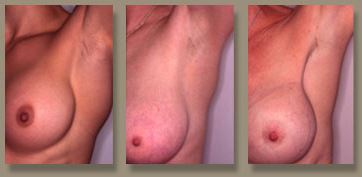Patients who are considering breast enhancement surgery, often have have concerns about scarring. Breast augmentation involves surgical incisions, so it is not possible to completely eliminate scarring but with careful planning and attention to detail, I anticipate that my patients will find their scarring to be minimal and very acceptable.
There are three incisions that are commonly during breast augmentation surgery:
The periareolar incision, once healed, is “hidden in plain sight” along the border of the areola where the skin transitions in color and texture to the surrounding skin of the breast. This incision allows more surgical shaping of the breast to be done for patients with specific problems with their natural breast shape. It is also the best approach for any secondary surgery. Either silicone gel or saline implants may be used through this incision site. The size of the areola and the size of the implant are usually not an issue, but are considerations during the planning process.
If the breasts are full enough to produce a fold beneath, then the inframammary incision can be an option. Very large cohesive implants may require this approach though any implant can be used through this approach.
It tends to be more visible than the other incision locations, and as a result, I do not recommend this approach very often.
A transaxillary incision is a good choice for patients who do not want any scarring on the breast at all. The incision is placed high up in the zone of hair bearing skin and will fade into a naturally occurring crease in the underarm. Because the incision is so small, saline implants are the most commonly used implant style for this approach.

These are the variables that can affect the final healing of your surgery scars:
Once surgery is completed, the incision site is protected by a sterile dressing and often reinforced with special tapes. Post-op instructions are designed to help the healing process. Patients are asked to avoid any stress or trauma to the incision site. Antibiotics are usually prescribed to help prevent infections. I always advise my patients to call the office if they have any concerns regarding the way their incision is healing. Fortunately, most incisions heal without problems and leave scars that are minimal and well hidden.